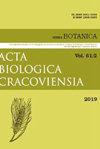Nuclear DNA Content and Ploidy Level of Apple Cultivars Including Polish ones in Relation to Some Morphological Traits
IF 0.5
4区 生物学
Q4 PLANT SCIENCES
引用次数: 21
Abstract
Apple species and cultivars differ in nuclear (2C) DNA content and ploidy level. The majority of these genotypes are diploids, but there are some triploids and a few tetraploids. Nuclear DNA content is a specific feature and its flow cytometric evaluation can be helpful in differentiating taxa. For many apple genotypes – including all the Polish ones, these characteristics are not known. 2C DNA was evaluated in relation to leaf, flower, fruit, pollen grain and stomata sizes as well as to the flowering time for seventy genotypes (including 46 Polish cultivars) gathered in the gene bank of the Research Institute of Horticulture, Skierniewice, Poland. For standard cultivars with the known chromosome number, 2C value was 1.71 pg for diploid cultivar ‘Alwa’ (2n=2x=34), 2.55 pg for triploid ‘Boskoop’ (3x=51), and 3.37 pg for tetraploid genome (4x=68) of mixoploid ‘McIntosh 2x+4x’. In 61 cultivars (including 41 Polish ones), the nuclear DNA content ranged from 1.58 to 1.78 pg indicating their diploid chromosome number. Five cultivars were identified as triploids (‘Bursztówka Polska’, ‘Pagacz’, ‘Rapa Zielona’, ‘Rarytas Śląski’ and ‘Witos’) owing to their nuclear DNA amount ranging between 2.42 and 2.58 pg. Leaf, flower, fruit, stomata and pollen grain sizes were on average significantly larger in triploids. Thus, in 3x plants the mean leaf surface was 49.1 cm2, flower diameter – 52.4 mm, fruit weight – 204.7 g, stomata length – 32.1 μm and pollen grain diameter – 33.7 μm, whereas in diploids – 36.0 cm2, 46.1 mm, 162.7 g, 28.4 μm and 30.7 μm, respectively. Pollen grain viability was on average significantly higher in diploids (75.6%), compared to triploids (22%). These results confirm that in apple, as in many other plant species, the higher ploidy level of triploids is generally associated with increased sizes of pollen grains, stomata, flowers, fruits and leaves but decreased pollen viability. No clear correlation between ploidy level and flowering time was found. In the case of mixoploid apple genotypes possessing diploid and tetraploid genomes, some phenotype observation is helpful in describing the ploidy level of the histogenic layers, L1 and L2. Small stomata sizes (similar to diploid) indicate diploid L1 and larger leaf sizes, compared to diploid counterparts, show tetraploid L2. The results will be used for breeding, in which it is important to determine maternal and paternal genotypes as well as the direction of the crossing that is of great importance in obtaining seeds and materials for further selection.包括波兰品种在内的苹果品种核DNA含量和倍性水平与某些形态性状的关系
苹果品种和栽培品种的核(2C) DNA含量和倍性水平存在差异。这些基因型大多数是二倍体,但也有一些三倍体和少数四倍体。核DNA含量是一个特定的特征,其流式细胞术评价可以帮助区分分类群。对于许多苹果基因型,包括所有波兰苹果基因型,这些特征是未知的。对收集在波兰skerniewice园艺研究所基因库中的70个基因型(包括46个波兰品种)的叶片、花、果实、花粉粒和气孔大小以及开花时间进行了2C DNA评估。对于已知染色体数的标准品种,二倍体‘Alwa’(2n=2x=34)的2C值为1.71 pg,三倍体‘Boskoop’(3x=51)的2C值为2.55 pg,混合倍体‘McIntosh 2x+4x’的四倍体基因组(4x=68)的2C值为3.37 pg。61个品种(包括41个波兰品种)的核DNA含量在1.58 ~ 1.78 pg之间,表明其二倍体染色体数目。5个品种(' Bursztówka Polska ', ' Pagacz ', ' Rapa Zielona ', ' Rarytas Śląski '和' Witos ')鉴定为三倍体,因为它们的核DNA含量在2.42 ~ 2.58 pg之间。三倍体的叶、花、果实、气孔和花粉粒平均较大。结果表明,三倍体的平均叶面面积为49.1 cm2,花直径为52.4 mm,果实重为204.7 g,气孔长为32.1 μm,花粉直径为33.7 μm,而二倍体的平均叶面面积为36.0 cm2,花直径为46.1 mm,花直径为162.7 g,花直径为28.4 μm,花粉直径为30.7 μm。二倍体的花粉粒活力(75.6%)显著高于三倍体(22%)。这些结果证实,在苹果中,与许多其他植物物种一样,三倍体的高倍性水平通常与花粉粒、气孔、花、果和叶的大小增加有关,但花粉活力降低。倍性水平与开花时间没有明显的相关性。对于具有二倍体和四倍体基因组的混合倍体苹果基因型,一些表型观察有助于描述组织发生层L1和L2的倍性水平。气孔小(与二倍体相似)表示二倍体L1,叶片大(与二倍体相比)表示四倍体L2。这些结果将用于育种,在育种中,确定母本和父本基因型以及杂交方向对获得进一步选择的种子和材料具有重要意义。
本文章由计算机程序翻译,如有差异,请以英文原文为准。
求助全文
约1分钟内获得全文
求助全文
来源期刊
CiteScore
3.00
自引率
0.00%
发文量
0
审稿时长
>12 weeks
期刊介绍:
ACTA BIOLOGICA CRACOVIENSIA Series Botanica is an English-language journal founded in 1958, devoted to plant anatomy and morphology, cytology, genetics, embryology, tissue culture, physiology, biochemistry, biosystematics, molecular phylogenetics and phylogeography, as well as phytochemistry. It is published twice a year.

 求助内容:
求助内容: 应助结果提醒方式:
应助结果提醒方式:


